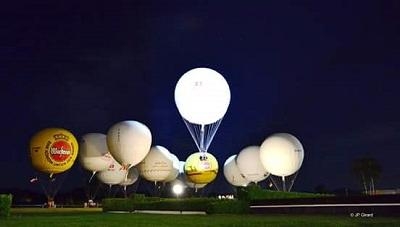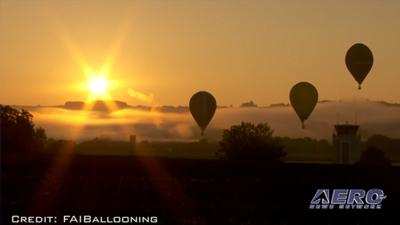Sixtieth Coupe Aéronautique Gordon Bennett Underway
The race is on! Gas-balloonists from a dozen countries launched late on Sunday night 18 September 2016 at the start of what is aviation’s oldest and most prestigious gas-balloon race – the 60th Coupe Aéronautique Gordon Bennett.

Forty-eight pilots in 24 gas-balloons – two pilots in each balloon – set off from Gladbeck, northwest Germany around midnight, launching into a moonlit sky and heading south, carried along only by the wind.
Rising quickly into the air each balloon was launched individually under the glare of floodlights as a sound system played out the respective pilots’ national anthem.
Among the many nationalities taking part, host-nation team GER-01, consisting of Wilhelm Eimers and co-pilot Matthias Zenge, climbed into their basket and waved goodbye to a cheering crowd as they embarked on their adventure.
It is the 26th time Eimers, 66, has flown in the Gordon Bennett and he is one of the favourites to win. “We hope to have a safe flight to south-eastern Europe,” he said before he launched. “Greece is a beautiful country!”
The format of the Coupe Aéronautique Gordon Bennett has changed little since its beginnings some 110 years ago in 1906.
That was when US newspaper tycoon Gordon Bennett – the same man who sent Stanley to find David Livingstone in Africa – founded a gas-balloon race in France. Then, 16 balloons launched from the Tuileries Gardens in Paris in front of a crowd of 200,000.
The winners, Frank Lahm and Henry Hersey, won by flying an open distance straight-line of 641.1 km (approx. 346 nm). The next year the race was held in St Louis, MO, and the winner flew more than double that – 1,403.55 km (approx. 758 nm).
A legendary race was born.

Since those early days the basic equipment used in the race of open basket and gas balloon has remained much the same, as has the premise of the race: the balloon that goes the furthest, wins.
“It is a huge challenge,” said Eimers, “it is technical, it involves meteorology and the weather, and it is a battle of the human spirit to fly for so long in such basic conditions.”
This year pilots are heading south from Germany towards France, Spain and the Mediterranean. Poor weather over the Alps means pilots will be using the wind to track west of the mountains, possibly heading out over the Mediterranean to the islands of Sardinia and Sicily – the winners may well land in Crete or mainland Greece, a straight-line distance of almost 2,000 km (approx. 1,080 nm).
Pilots in the Coupe Aéronautique Gordon Bennett can fly for up to 80 hours, held aloft purely by the hydrogen. Home for those three days and nights is a small, traditional wicker basket barely the size of a family dinner table. Both pilots must live, breathe, eat, sleep, work and fly together in a space no bigger than 5 feet by 5 feet.
The race attracts a large international following of digital spectators as each balloon can be tracked online. Pilots carry a satellite tracker that broadcasts their position to the competition website every few minutes. Spectators can watch the race happen in ‘real time’ as pilots battle with weather, wind, tactics and strategy.
(Source: Gordon Bennett Balloon Race news release. Images from file)
 ANN's Daily Aero-Term (05.29.25): Terminal Radar Service Area
ANN's Daily Aero-Term (05.29.25): Terminal Radar Service Area ANN's Daily Aero-Term (05.30.25): Very High Frequency (VHF)
ANN's Daily Aero-Term (05.30.25): Very High Frequency (VHF) Aero-News: Quote of the Day (05.30.25)
Aero-News: Quote of the Day (05.30.25) Airborne 05.23.25: Global 8000, Qatar B747 Accepted, Aviation Merit Badge
Airborne 05.23.25: Global 8000, Qatar B747 Accepted, Aviation Merit Badge ANN's Daily Aero-Linx (05.30.25)
ANN's Daily Aero-Linx (05.30.25)




